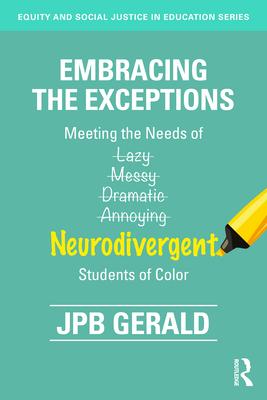Neurodivergent students of color are often overlooked, as research and teaching strategies predominantly focus on white males in the classroom. How can we help teachers reach all students to honor their full humanity, and to understand how ableism - neuronormativity in particular - and racism intersect on our bodies and brains? JPB Gerald's fascinating book offers a blend of narrative and interviews to show what would help neurodivergent students of color feel more supported and cared for in schools, and to demonstrate how much better their lives could be when they feel that love. Each chapter covers a common trait among neurodivergent students, and concludes with takeaways and approaches for supporting our youth in the classroom. Turning from a deficit-based look to a strength-based one, JPB helps us see how NDSOC students think and learn differently, and how we can do right by them, supporting them more effectively in the classroom and beyond.

Embracing the Exceptions: Meeting the Needs of Neurodivergent Students of Color
Neurodivergent students of color are often overlooked, as research and teaching strategies predominantly focus on white males in the classroom. How can we help teachers reach all students to honor their full humanity, and to understand how ableism - neuronormativity in particular - and racism intersect on our bodies and brains? JPB Gerald's fascinating book offers a blend of narrative and interviews to show what would help neurodivergent students of color feel more supported and cared for in schools, and to demonstrate how much better their lives could be when they feel that love. Each chapter covers a common trait among neurodivergent students, and concludes with takeaways and approaches for supporting our youth in the classroom. Turning from a deficit-based look to a strength-based one, JPB helps us see how NDSOC students think and learn differently, and how we can do right by them, supporting them more effectively in the classroom and beyond.